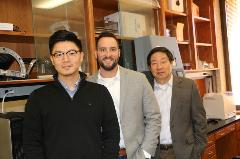 OKLAHOMA CITY AND NORMAN – In people with diabetes, diabetic retinopathy is a frequent complication and the most common cause of vision loss. To curtail the prevalence of the devastating eye disease, University of Oklahoma researchers on both the Oklahoma City and Norman campuses have launched a pharmaceutical company to develop a new treatment.
OKLAHOMA CITY AND NORMAN – In people with diabetes, diabetic retinopathy is a frequent complication and the most common cause of vision loss. To curtail the prevalence of the devastating eye disease, University of Oklahoma researchers on both the Oklahoma City and Norman campuses have launched a pharmaceutical company to develop a new treatment.
The company Excitant Therapeutics was formed to commercialize research being conducted at the OU Health Sciences Center in Oklahoma City. The research comes from the laboratory of physiologist Jian-Xing “Jay” Ma, M.D., Ph.D., whose career has largely focused on diabetic retinopathy. Dr. Ma co-founded Excitant Therapeutics with Adam Duerfeldt, Ph.D., a medicinal chemist on OU’s Norman campus, and Younghwa “Henry” Shin, Ph.D., who was a graduate student and postdoctoral fellow in Dr. Ma’s laboratory.
Because their discoveries show significant potential to treat diabetic retinopathy, they decided to commercialize the research and develop a new, more effective therapy than is currently available.
“We are excited that research conducted at the OU Health Sciences Center will be developed into a new therapy that will more effectively treat diabetic retinopathy,” said Dr. Ma, who also serves as chairman of the Department of Physiology at the OU College of Medicine. “The current standard of care fails to treat about 40% of patients, and it involves monthly injections directly into the eye. This research serves as the starting point for a new treatment that is effective for more people and can be given as an eye drop or a pill.”
The research of Excitant centers around a protein in the body called PPAR-alpha (peroxisome proliferator-activated receptor alpha). When activated, PPAR-alpha decreases the prevalence of diabetic retinopathy. Researchers in Dr. Ma’s lab discovered compounds that target PPAR-alpha and are structurally different from those in other known drugs.
The research of Excitant has taken a somewhat unique trajectory among pharmaceutical start-up companies. They became aware of a clinical trial by another organization that failed in its primary goal but offered a serendipitous finding – the drug being tested activated PPAR-alpha and slowed the progression of diabetic retinopathy. However, that drug is not selective nor very potent, yet it is toxic in higher amounts. The Excitant researchers knew their compounds could not only activate PPAR-alpha, but have the potential to more effectively and safely treat diabetic retinopathy. And because the other clinical trial demonstrated it was safe to activate PPAR-alpha in humans, the journey toward earning an investigational new drug application from the FDA may be smoother.
Excitant is also developing drug therapies that can target the multiple pathological features of diabetic retinopathy. The current treatment, eye injections, only targets the abnormal blood vessel growth that penetrates the retina. However, that’s only one part of the disease.
“Inflammation and neuronal cell death in the retina are other features of diabetic retinopathy,” said Dr. Shin, who serves as CEO of Excitant Therapeutics. “Ours is a multi-pronged approach to a complex disease. We believe we can simultaneously target all features of the disease, and that we’ll be able to help the 40% of the patient population that is unresponsive to the current standard of care.”
Transforming basic science research into an FDA-approved treatment is a long journey but a gratifying one, said Dr. Duerfeldt, who brings expertise in turning a promising molecule into a drug lead. “When I present our results, it’s not unusual for people to come up to me afterward to relay that a relative of theirs has diabetic retinopathy or that they have diabetes and are worried about eye problems,” he said. “It puts our research into perspective and emphasizes that what we’re doing is needed and important.”
Since forming as a company last year, Excitant has licensed its technology and received a federal Small Business Innovation Research (SBIR) Phase 1 award to further its work. It has established its laboratory home base at Oklahoma Christian University, where students can be exposed to the science and business development.
The company also has been supported by OU’s Office of Technology Commercialization (OTC), which served as “matchmaker” for the cross-campus collaboration. OTC is crucial to the launch of start-up companies, helping scientists obtain patents, file for copyrights and trademarks, evaluate a product’s fit in the market, and much more. OTC also presented Excitant a Growth Fund Award, the mechanism for reinvesting a portion of the royalties received from licensing activities.
“Having both clinical and disease state expertise at our Health Sciences Center campus and a growing medicinal chemistry group in Norman allows us to create partnerships that advance the science to a more viable stage for outside investment,” said Gina McMillen, DVM, Ph.D., director of OTC at the OU Health Sciences Center. “We have been working with these scientists for several years, and bringing them together has brought tremendous value, efficiency and acceleration to the program. We are excited that this research may one day changes lives.”